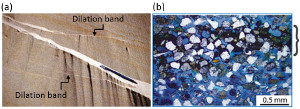|
Dilation bands are deformation bands which are characterized predominantly by positive volume change with respect to the undeformed state (Figure 1 and Figure 2), and have no detectable macroscopic shear offset (Du Bernard et al., 2002; Fossen et al., 2007). It appears that the magnitude of the dilational volume change is either relatively small or the original volume expansion cannot be maintained throughout the post deformation phase. Du Bernard et al. (2002) reported about 7% volume increase at the samples they studied. The lack of overall shear offsets can be determined from crosscutting relations of the bands with depositional markers and/or older deformation bands. Bands at low angle to, and associated with the tips of shear bands with clear evidence for the sense of shearing are also used to infer a dilational volumetric deformation across the band segments. Bands spatially associated with two conjugate sets of shear bands and located in the extensional quadrants are also interpreted as dilation bands by these authors.
 | | Figure 1. (a) Photo showing a dilation band in sandstone, Tayeba Mine, Western Sinai. From Haakon Fossen, available from http://www.uib.no/people/nglhe/Research.html. (b) Photomicrograph of a dilational deformation band created through triaxial compression testing of Wingate sandstone. Blue resin fills the pore spaces between lightly-cemented quartz and feldspar grains, as well as within the band itself. Copyright Chris H. Okubo, University of Arizona. Available from http://www.lpl.arizona.edu/~chriso/rockmechanics.html. |
 | | Figure 2. (a) Map of dilation bands associated with a low-angle shear band of thrust sense in poorly consolidated deposits of the Savage Creek marine terrace, McKinleyville, California. (b) One of the dilation bands shown in (a) in thin section. Blue corresponds to an epoxy material filling the pore space. The macroscopic band of about 1 mm in thickness corresponds to that identified in the photomicrograph, which is highligted by a relative concentration of darker cement composed of clay minerals, iron oxide, and organic matter. From Du Bernard et al. (2002). |
Laboratory observations of dilation bands have also been reported (Bésuelle, 2001; Mukhamediev and Ul'kin, 2011; Okubo (personal web site) and Chemenda et al., 2012).
| |
Antonellini, M., Aydin, A., Pollard, D.D., 1994. Microstructure of deformation bands in porous sandstones at Arches National Park, Utah. Journal of Structural Geology 16: 941–959.
Bésuelle, P., 2001. Compacting and dilating shear bands in porous rock: Theoretical and experimental conditions. Journal of Geophysical Research 106: 13435-13442.
Chemenda, A.I., Nguyen, S.H., Petit, J.P., Ambre, J., 2011. Mode I cracking versus dilatancy banding: experimental constraints on the mechanisms of extension fracturing. Journal of Geophysical Research 116: B04401. doi:10.1029/2010JB008104.
Du Bernard, X., Eichhubl, P., Aydin, A., 2002. Dilation bands: a new form of localized failure in granular media. Geophysical Research Letters 29 (24): 2176 doi: 1029/2002GLO15966.
Fossen, H., Schultz, R.A., Shipton, Z.K., Mair, K., 2007. Deformation bands in sandstone: a review. Journal of the Geological Society 164: 755-769.
Mukhamediev, Sh.A., Ul'kin, D.A., 2011. Formation of systems of incompact bands paralllel to the compression axis in the unconsolidated sedimentary rocks: A model. Izvestiya, Physics of the Solid Earth 47 (10): 886-901.
|

